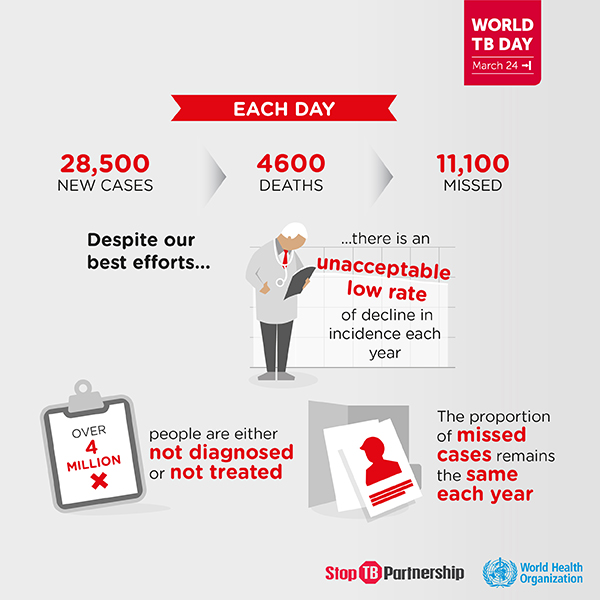March 22, 2018
Each day, Rashidi Gora climbs onto his motorcycle and rides into remote villages in the Kondoa District of Tanzania. A community health worker, Rashidi spends his days searching for cases of tuberculosis (TB) in places where people are often overlooked by traditional health systems. Rashidi is a crucial piece of a broad system for finding and testing for TB cases.
 On World TB Day, as Rashidi rides his motorcycle to locate TB cases, the world looks to successes and challenges in the fight against this deadly disease. One of the biggest hurdles in ending the TB epidemic is finding the millions of missing cases of TB. Every year, of the 10.4 million people who get sick with the disease, 40 percent are missed by the health system and do not receive care.
On World TB Day, as Rashidi rides his motorcycle to locate TB cases, the world looks to successes and challenges in the fight against this deadly disease. One of the biggest hurdles in ending the TB epidemic is finding the millions of missing cases of TB. Every year, of the 10.4 million people who get sick with the disease, 40 percent are missed by the health system and do not receive care.
Medical innovation is an important piece of the strategy to defeat TB. The development of both an easier treatment plan and a new vaccine for TB would be major game-changers, particularly as the serious public health challenge of multi-drug resistant TB becomes more prevalent. But at its core, the global community knows how to treat TB. The innovation needed to end TB is not simply one of developing better medicine.
One of the biggest challenges for tackling TB is reaching the people who live with it, and ensuring they are able to successfully complete treatment. Reaching everyone who is living with TB is crucial because without that first step — identifying each case of TB — the next steps of treatment are impossible. It is not an easy task, but finding innovative ways to identify missing cases is an opportunity to make huge gains in the TB fight.
Fortunately, the Global Fund is focused on tackling this very issue. Seventy percent of all people with TB who are missed by current systems are located in 13 countries. The Global Fund’s goal is to find an additional 1.5 million TB cases in those 13 countries by 2019. They are pursuing this goal through the TB Catalytic Investment initiative, which includes:
- $115 million in matching funds designed to support country-led programs.
- A strategic initiative with an additional $10 million will be used to help technical partners to develop tools based on best practices.
- Finally, a $65 million multi-country investment will address cross-border issues such as drug-resistant TB response among migrant workers, and provide treatment to refugees and displaced people.
These funds will help the world find those missing cases and take us one step closer to ending this epidemic.
The Global Fund’s new Executive Director, Peter Sands, views innovative approaches such as the TB Catalytic Investment Initiative as key to effective global health policy. He and Stop TB Executive Director Lucica Ditiu recently highlighted the importance of “more efficient case finding” and “diagnosis and treatment” in the fight to end the TB epidemic.
In Tanzania, Rashidi is doing his part to tackle tuberculosis. Programmatic innovations like the TB Catalytic Investment Initiative demonstrate why it is so important that the United States maintains its leadership role and commitment to the Global Fund. With steady investment from partners around the world, the Global Fund can continue investing strategically in health workers to tackle TB head-on, and end epidemics where they start. An end to the TB epidemic will mean a safer world for everyone.
Ahead of World TB Day, the Global Fund published this infographic and photo story. The Stop TB Partnership has World TB Day materials available here, and the Centers for Disease Control and Prevention published a resource library here.
